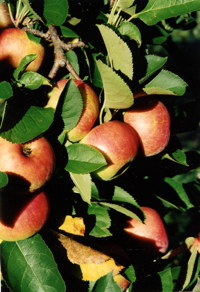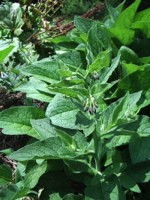The Functional Orchard
“The whole is greater than the sum of its parts.”

The 15-year-old “functional orchard” in our backyard is looking more like a jungle each year. That’s intentional. The idea is to grow fruit trees in a mixed plant environment and see what happens. You might call it semi-organized chaos. Our friend Mike calls it Jurassic Park.
Fifty standard-sized apple trees surround a small pond in three concentric ovals in a one-acre clear cut. Soil improvement has been primarily accomplished by laying down brush and covering it when possible with soil, compost or manure. Any plants we snip off or pull out get cut into pieces and tossed right there on the ground. The orchard floor becomes the compost heap, as it is in nature. Some new plantings get fertilizer or compost, but mostly all the plants and the apple trees are fertilized by the decomposition of plant matter.
The site is now a menagerie of dozens of woody and herbaceous “companion” plants, some introduced and others wild “volunteers.” Among the apple trees we’ve planted blueberries, clethra, elderberries, Pagoda dogwood, various Viburnums and willows. We have raspberry and blackberry canes, grapes, honeysuckle and schisandra vines. We even planted a catalpa tree, now getting very large!
The herbaceous perennial plants range in height from low groundcovers to 3–4" tall. We are maximizing flowers and aromatics and welcoming plants we might discourage in our vegetable garden, like nettles, tansy, goldenrod, yarrow, Queen Anne’s lace and comfrey. We’re especially partial to plants that like to form seedling populations. Three favorites are boneset, monarda and valerian.
Early on in the project, I was tempted to remove all the volunteer plants that were appearing spontaneously. After all, this is agriculture and I should be in control, shouldn’t I? But I’ve resisted the temptation to weed out the “weeds.” Agriculture should be a partnership between plants and people. I want to have a hand in what’s going on in the functional orchard, but not a heavy hand. I want to trust the plants themselves. If they want to be there, there’s probably a good reason.
It’s not entirely laissez-faire however. I keep the base of each apple tree cleared to about 36" out. I also thin or cut back nearly everything when I prune the orchard in winter, which is time-consuming but worth it. By early summer, the site is packed with plants. I shudder to think what it would look like if I didn’t cull. I also keep a path mowed to every tree. I want access. This is an orchard, not the woods.
I get out into the functional orchard as often as I can. Often I have no plan. I just take a few tools with me and go see what comes next. Mostly I try to observe. Constant observation is essential to learning. When it comes to noticing, you can’t overdo it.
A few observations:

- The apple trees seem to like the current set-up. They are thriving among all the companions. Shoot growth and foliage color are good.
- The soil is improving. We started with a woodsy duff and ledge. The soil is moist, and the color is darkening.
- There has been practically no borer damage to the apple trees. Other young trees on the farm have been hit by borers, but something about this orchard seems to be fooling them. Could diversity be the best protection?
A few challenges:
- Voles like the arrangement. Our cat, the owls and the local goshawk have been hard at work, but still we have voles. Clearing vegetation from right around the tree trunks is especially important in discouraging voles from nibbling on bark.
- The fertility, soil type and water availability varies throughout the woodsy site. Four trees of fifty inexplicably died to the ground in the past 15 years. My best guess is that we planted these four in spots that were deficient in nutrients or received too much water. We removed two of them, adjusted the soil a bit, and replanted. Those new trees are now doing well. We cut the other two to the ground, and they have re-sprouted and are doing fine.
The future:
There is still so much to learn! We hope to continue to reduce external inputs—including sprays—eventually to zero. It’s possible that specific companion plants deter specific pests, but I suspect it is the totality of the community of plants, not the individual species, that will ultimately be our best strategy. While the scientific method isolates and tests, the functional orchard is about creating an interconnected community of plants—a balanced ecosystem—where each plant plays a role in a complicated system. The whole is greater than the sum of its parts. Or as we like to say, “Multifactorial Synergy!”
John Bunker
